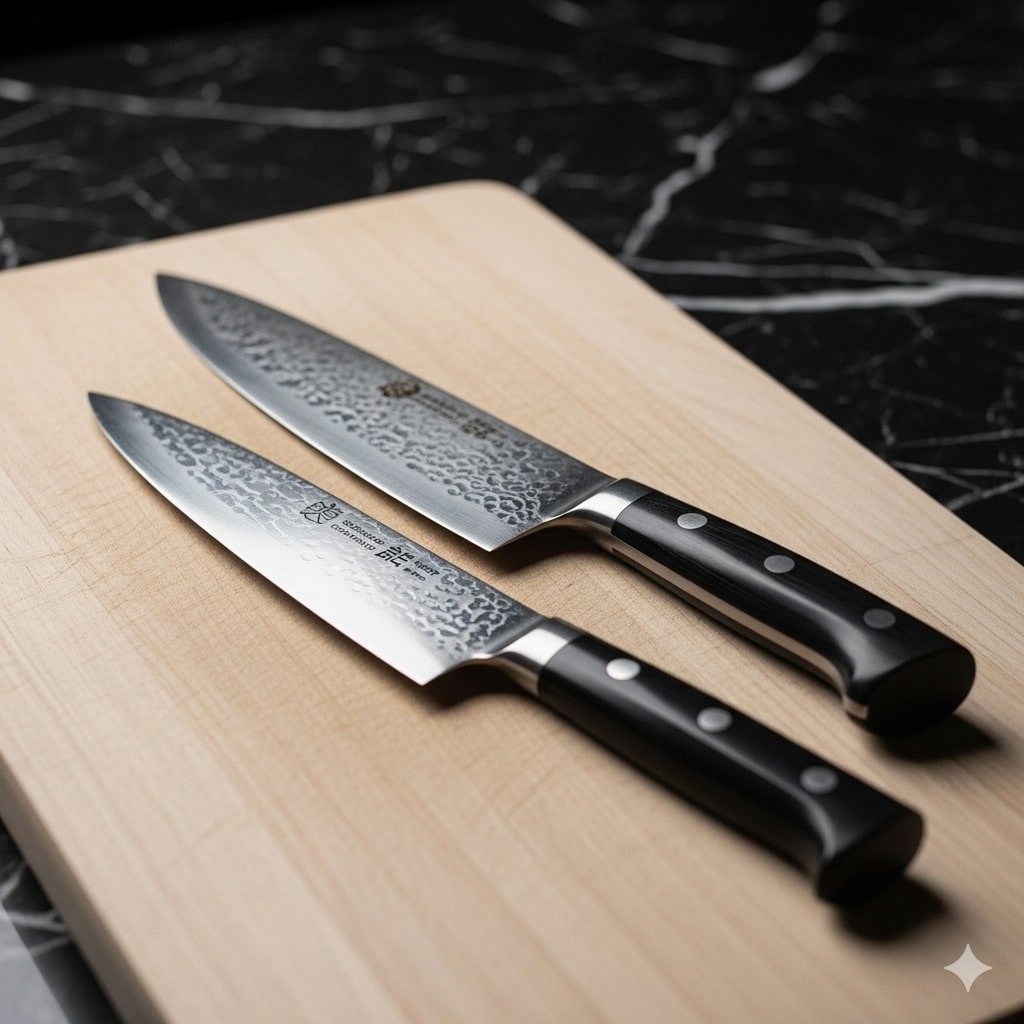Published on August 28, 2025 by Filip
Last updated on August 28, 2025

Western vs Japanese chef knives, what’s the difference? Professional chefs have immense loyalty to each knife they use, and a lot of them swear by rock-solid German chef’s knife that they’ve used for years, whereas many also prefer a razor-sharp Japanese gyuto. Is one better than the other? The answer is no – they are preferences at hand here, and in fact; many cooks – both beginners and professionals – use both.
In this in-depth expert guide, I explain all the why’s and the how’s of Japanese and Western kitchen chef knives.
This split is a product of centuries of different cooking philosophies and culinary demands.
In the West, knives evolved alongside meat-heavy cuisines. German and French blades became durable workhorses, capable of breaking down and slicing meat, as well as chopping vegetables. They’re designed to survive heavy-use and long days – even the occasional bone impact – without much complaint.
Japan took a different path. Rooted in meticulous sword-smithing techniques of the samurai era, Japanese chef knives became tools of precision. Each blade shape serves a specific role: the Yanagiba for silky sashimi slices, the Deba for breaking down fish, the Nakiri for whisper-thin vegetable cuts, and so on. The focus is on precision, sharpness, and honoring the ingredient’s natural texture.
This guide will do more than simply compare Western vs Japanese chef knives. I will break down every major knife type in both traditions. Moreover, I will explain how they work, who they’re for, and how they fit together in a kitchen. By the end, you’ll know exactly which knives deserve a spot in your cutting board – and why.
Philosophy and Craftsmanship Differences Between Western and Japanese Chef Knives
Before we compare individual knife types, I must note that the mindset which shaped each tradition is worthy of understanding.
Western and Japanese chef knives aren’t merely different in appearance. They’re rather built around different ideas of what a kitchen chef knife should do and how it should feel in your hand.
Blade Geometry & Cutting Style
- Western Approach: German and French knives typically have a pronounced curve along the cutting edge. This supports the “rock chop” technique, where the knife pivots on the board while the heel stays in contact. The blades are thicker, with a sturdy spine, and designed to handle a wide range of foods — from dense squash to whole poultry.
- Japanese Approach: Most Japanese knives have a flatter edge profile, encouraging a push or pull slicing motion rather than rocking. The blades are thinner, reducing resistance through food and allowing for cleaner, more precise cuts. This design rewards finesse but punishes twisting or prying.
Steel & Edge Retention
- Western: Heavier overall, often with a full tang (steel running through the handle) and a bolster that adds weight between blade and handle. The result is a balanced, stable feel that suits repetitive chopping.
- Japanese: Lighter, with traditional wa-handles made from ho wood or magnolia, often without bolsters. This shifts the balance point toward the blade, giving more agility and control in slicing motions.
4. Maintenance & Sharpening
- Western: Designed for easy upkeep. A honing rod keeps the edge aligned between sharpenings, and a whetstone or professional service restores sharpness as needed. The softer steel makes them less intimidating for beginners.
- Japanese: Require more deliberate care. Harder steel demands sharpening on a whetstone at the correct angle — typically 12–15° per side. Many are single bevel, which requires learning a different sharpening technique. They must be hand-washed, dried immediately, and stored carefully to prevent rust or damage.
Understanding these core differences will make the next sections much more useful. When we dive into each knife family – Western vs Japanese – you’ll see how these philosophies translate into specific blade shapes, sizes, and uses.
Complete Western Knife Family – Profiles
An overview of typical Western knife types, their Japanese equivalents, and each one’s ideal uses in your kitchen.
Chef’s Knife
Japanese Equivalent: Gyuto
Blade: 8–12″, pronounced curve
Hardness: HRC 54–58
Best For: All-purpose chopping, slicing, dicing
Models: Wüsthof Classic, Victorinox Fibrox
Paring Knife
Japanese Equivalent: Petty
Blade: 3–4″, narrow, pointed tip
Hardness: HRC 54–58
Best For: Peeling, trimming, detail work
Models: Victorinox 3.25″, Henckels Classic
Utility Knife
Japanese Equivalent: Small Petty / Santoku
Blade: 4–7″, slim with slight curve
Hardness: HRC 54–58
Best For: Mid-size tasks (sandwiches, cheese)
Models: Wüsthof Classic 6″, Global GS-5
Carving Knife
Japanese Equivalent: Sujihiki
Blade: 8–14″, long, narrow, straight
Hardness: HRC 54–58
Best For: Roasts, poultry, ham
Models: Victorinox Fibrox Slicing, Shun Classic
Bread Knife
Japanese Equivalent: None exact
Blade: 8–10″, serrated edge
Hardness: HRC 54–56
Best For: Bread, cakes, tomatoes
Models: Mercer Millennia, Tojiro Bread Slicer
Boning Knife
Japanese Equivalent: Honesuki
Blade: 5–7″, narrow, flexible or stiff
Hardness: HRC 54–58
Best For: Removing bones from meat, poultry
Models: Wüsthof Classic, Victorinox Fibrox
Filleting Knife
Japanese Equivalent: Deba (for fish)
Blade: 6–9″, thin, flexible
Hardness: HRC 54–57
Best For: Filleting fish, skinning delicate cuts
Models: Rapala Fish Fillet, Zwilling Pro
Cleaver
Japanese Equivalent: None direct
Blade: 6–12″, rectangular, thick, heavy
Hardness: HRC 54–58
Best For: Chopping through bones, butchery
Models: Dexter-Russell, Wüsthof Classic
Butcher Knife
Japanese Equivalent: Garasuki
Blade: 8–14″, curved tip
Hardness: HRC 54–58
Best For: Breaking down large cuts, trimming fat
Models: Victorinox Butcher, Old Hickory
Tomato Knife
Japanese Equivalent: None exact
Blade: 4–6″, serrated, forked tip
Hardness: HRC 54–56
Best For: Tomatoes, soft fruits, citrus
Models: Wüsthof Classic, Victorinox Tomato
Steak Knife
Japanese Equivalent: None (table use)
Blade: 4–6″, serrated or straight
Hardness: HRC 54–56
Best For: Table service for meat
Models: Laguiole Steak Knife, Zwilling Steak Set
Offset Serrated
Japanese Equivalent: None
Blade: 8–9″, serrated, offset handle
Hardness: HRC 54–56
Best For: Bread, pastries, sandwiches
Models: Dexter-Russell Offset, Mercer Millennia
Complete Japanese Knife Family – Profiles
An overview of common Japanese knife types, their Western equivalents, and their ideal uses in the kitchen.
Gyuto
Western Equivalent: Chef’s Knife
Blade: 8–12″, curved belly, pointed tip
Hardness: HRC 58–62
Best For: All-purpose chopping, slicing, dicing.
Lightweight and precise, but the edge can be brittle if misused.
Models: Masamoto VG, Shun Classic Gyuto
Petty
Western Equivalent: Paring / Utility Knife
Blade: 3–6″, narrow, pointed tip
Hardness: HRC 58–62
Best For: Peeling, trimming, small slicing tasks.
Extremely versatile for detail work, replacing both paring and small utility knives.
Models: Misono Petty, Tojiro DP Petty
Santoku
Equivalent: Between Chef’s & Utility
Blade: 5–7″, flat edge, sheep’s-foot tip
Hardness: HRC 58–62
Best For: Vegetables, fish, boneless meats.
Great all-rounder for push-cutting; less rocking motion than a Gyuto.
Models: MAC Santoku, Global G-46
Sujihiki
Western Equivalent: Carving Knife
Blade: 9–14″, long, narrow
Hardness: HRC 59–62
Best For: Slicing roasts, fish fillets, raw proteins.
Thin blade creates ultra-clean cuts. Not for chopping.
Models: Sakai Takayuki Sujihiki, Masamoto KS
Nakiri
Equivalent: Vegetable Cleaver
Blade: 5–7″, straight edge, rectangular
Hardness: HRC 58–62
Best For: Precision vegetable work.
Flat edge is perfect for straight chopping and reduces “accordion cuts”.
Models: Shun Classic Nakiri, Tojiro DP Nakiri
Deba
Equivalent: Fillet/Butcher Hybrid
Blade: 6–9″, thick spine, single bevel
Hardness: HRC 58–62
Best For: Breaking down whole fish, light butchery.
Hefty enough for fish heads and bones, yet precise for filleting.
Models: Masamoto Deba, Yoshihiro Deba
Yanagiba
Equivalent: Long Slicing Knife
Blade: 9–14″, long, thin, single bevel
Hardness: HRC 60–64
Best For: Slicing sashimi and sushi.
The iconic sushi chef’s knife for creating flawless, clean slices.
Models: Sakai Takayuki Yanagiba, Masamoto Yanagiba
Honesuki
Western Equivalent: Boning Knife
Blade: 5–6″, triangular, stiff
Hardness: HRC 59–62
Best For: Deboning poultry, trimming meat.
Extremely precise with a strong tip for handling joints and cartilage.
Models: Tojiro Honesuki, Misono Honesuki
Garasuki
Western Equivalent: Butcher Knife
Blade: 8–10″, larger version of Honesuki
Hardness: HRC 59–62
Best For: Heavier poultry and butchery work.
Extra heft and reach for breaking down large cuts.
Models: Misono Garasuki, Masamoto Garasuki
Usuba
Equivalent: Pro, single-bevel Nakiri
Blade: 6–8″, flat edge, rectangular
Hardness: HRC 60–64
Best For: Traditional professional vegetable prep.
Single bevel allows for razor-thin slices but has a steeper learning curve.
Models: Sakai Usuba, Yoshihiro Usuba
Western vs Japanese Kitchen Knives – A Quick Visual Comparison
A detailed comparison of the core philosophies behind Western (German/French) and Japanese knife making.
Western Knives
- Blade Hardness (HRC)54–58 → Softer steel, less brittle
- Edge Type & AngleDouble bevel, ~20° per side
- Cutting StyleRock chop → curved belly supports pivot motion
- Blade ThicknessThicker spine, robust geometry
- DurabilityForgiving, handles bones & dense foods
- MaintenanceEasy upkeep → honing rod + periodic sharpening
- Best Fit ForBeginners, heavy prep, all-round utility
- DrawbacksLess precise, dulls faster
Japanese Knives
- Blade Hardness (HRC)58–64 → Harder steel, sharper edge
- Edge Type & AngleMostly double bevel (12–15°), some single bevel
- Cutting StylePush / pull slice → flatter edge for precision
- Blade ThicknessThinner spine, laser-like grind
- DurabilityMore brittle, chips if twisted or forced
- MaintenanceRequires whetstone sharpening & careful care
- Best Fit ForPrecision cooking, sushi/veg work, pros seeking sharpness
- DrawbacksBrittle, higher maintenance
🔪 Knife Edge Types & Grinds Explained
When you want to compare Western vs Japanese chef knives, you must understand that the edge geometry is equally important as the blade shape. The way a knife is ground will determine its sharpness, longevity while sharp, and the behavior of food as it slides off the blade.
Western Double-Bevel (20° per Side)
The majority of German and French knives use a symmetrical double bevel which is ground at roughly 20° on each side (40° total). This helps in creating a sturdy edge. This edge will resist chipping even if you slam your blade into a chicken bode, or twist it while cutting through dense vegetables.
The tradeoff here is sharpness, as they won’t feel razo-rlike, but they’ll be durable and forgiving for beginners, which is exactly why newcomers to the kitchen love them – as well as those working in busy kitchens (semi-pros, professionals, etc.)
Japanese Double-Bevel (12–15° per Side)
The Japanese gyuto – Santoku – and petty knives often keep the double-bevel profile, but at tighter angles – 12-15° per side (24-30° total). This narrower edge slices with notieably less resistance, which makes it ideal for thin cuts and precision cooking.
The downside is that harder steels at these acute angles can chip if the blade is twisted or forced. These knives reward smooth and deliberate cuts – but they will not tolerate sloppy techniques, which is why they’re seldom recommended to beginners.
Single-Bevel Knives (Yanagiba, Usuba, Deba)
This is where Japanese knives really diverge. Single-bevel edges are sharpened only on one side, with the other side is left flat or slightly concave. Because of this, the effect is dramatic: the knife acts like a wedge, steering the cut in a single direction and producing perfectly clean slices.
- Yanagiba: designed for sashimi, it creates one smooth pull cut with no tearing.
- Usuba: the professional vegetable knife, capable of translucent sheets of daikon.
- Deba: heavy fish knife, precise yet strong enough for heads and bones.
These edges unlock unmatched precision, but they’re advanced tools: they require specialized sharpening, they can steer awkwardly if used wrong, and they’re far less forgiving than double-bevel knives.
Hollow Grind vs Convex Grind
Edge geometry isn’t just about angle because the grind profile matters too.
- Hollow grind: concave sides behind the edge, found in some Western and Japanese knives. This makes the edge feel razor sharp but sacrifices durability. Hollow-ground knives glide through food but can dull faster.
- Convex grind: slightly bulging outward sides. This creates strength behind the edge, pushing food apart and improving durability. Convex grinds are harder to sharpen but provide better food release, meaning slices of potato or zucchini won’t suction-stick as easily.
